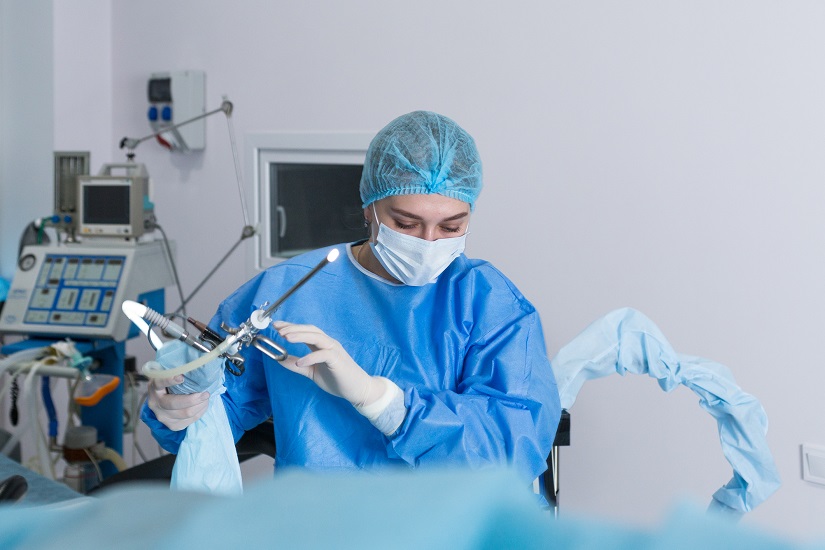Dysphoric milk ejection reflex (D-MER) is a condition that causes sudden negative emotions during...
Read More
Our experienced gynecologic surgery team offers minimally invasive hysteroscopies to diagnose and treat uterine conditions, providing you with the care and reassurance you deserve.
A hysteroscopy is a gynecologic procedure that allows doctors to look inside your uterus to diagnose and treat various gynecologic conditions. Your doctor may recommend this procedure when you have issues like abnormal bleeding, fertility issues or suspected abnormalities within the uterine cavity. By using a thin, lit tube called a hysteroscope, your doctor can get a clear view of the uterine lining and identify any problems that might be causing symptoms.
You may need a hysteroscopy if you have heavy or irregular menstrual cycles or bleeding between periods or after menopause. A hysteroscopy may help diagnose the cause of recurrent miscarriages or investigate findings from other tests, such as an ultrasound.
During a hysteroscopy, a hysteroscope is inserted through the vagina and cervix into the uterus, allowing your doctor to view the uterine cavity without incisions. Saline may be used to expand the uterus for a clearer view, aiding in detecting and treating abnormalities. This minimally invasive procedure offers shorter recovery times and lower complication risks, with most patients resuming normal activities within a few days.

A diagnostic hysteroscopy examines the inside of the uterus to diagnose issues such as abnormal bleeding, fibroids, polyps or congenital abnormalities. It helps investigate symptoms and confirm results from other diagnostic tests like ultrasounds.
An operative hysteroscopy can treat or correct identified problems within the uterus. During this procedure, the doctor can remove polyps or fibroids, take biopsies, remove scar tissue or perform sterilization procedures. An operative hysteroscopy can be performed immediately after a diagnostic hysteroscopy, avoiding the need for a second procedure.
Before your procedure, your doctor will provide specific instructions, such as avoiding tampons, douching or having sexual intercourse 24 hours before the procedure. You may also need to fast if anesthesia is required.
Your doctor might give you a local, regional or general anesthetic to ensure your comfort throughout the procedure. The doctor will insert the hysteroscope through your vagina and cervix and into your uterus. You may feel some cramping or discomfort, but it should be manageable. The procedure usually takes about 30 minutes, depending on whether additional treatments are needed.
After the procedure, you might experience light bleeding or cramping for a day or two. Your doctor will provide any necessary follow-up care instructions. Most people can return to regular activities within a few days, but follow your personalized guidance on rest and recovery.
While some discomfort during a hysteroscopy is possible, the procedure is typically well-tolerated. Your doctor may offer a local anesthetic to numb the cervix or a mild sedative to help you relax. You might feel light cramping or pressure as your doctor inserts the hysteroscope, but the discomfort should be brief and manageable.
Hysteroscopy is generally considered safe, but like any medical procedure, it carries some risks. These may include infection, bleeding, injury to the uterus or surrounding structures or a reaction to anesthesia. Serious complications are rare; your doctor will discuss these risks with you beforehand.
Hysteroscopy is a valuable diagnostic tool, but it may not detect all uterine abnormalities deep within the uterine muscle. In some cases, your doctor may order additional imaging or procedures for a more comprehensive evaluation of your uterine health. Your doctor will discuss these limitations and any additional testing they recommend based on your overall gynecologic health.

Dysphoric milk ejection reflex (D-MER) is a condition that causes sudden negative emotions during...
Read More
Polycystic Ovary Syndrome (PCOS) affects millions, yet many misconceptions still surround this...
Read More
From midwives and obstetricians to nurse practitioners and birthing coaches, here are the...
Read More
The material set forth in this site in no way seeks to diagnose or treat illness or to serve as a substitute for professional medical care. Please speak with your health care provider if you have a health concern or if you are considering adopting any exercise program or dietary guidelines. For permission to reprint any portion of this website or to be removed from a notification list, please contact us at (856) 537-6772